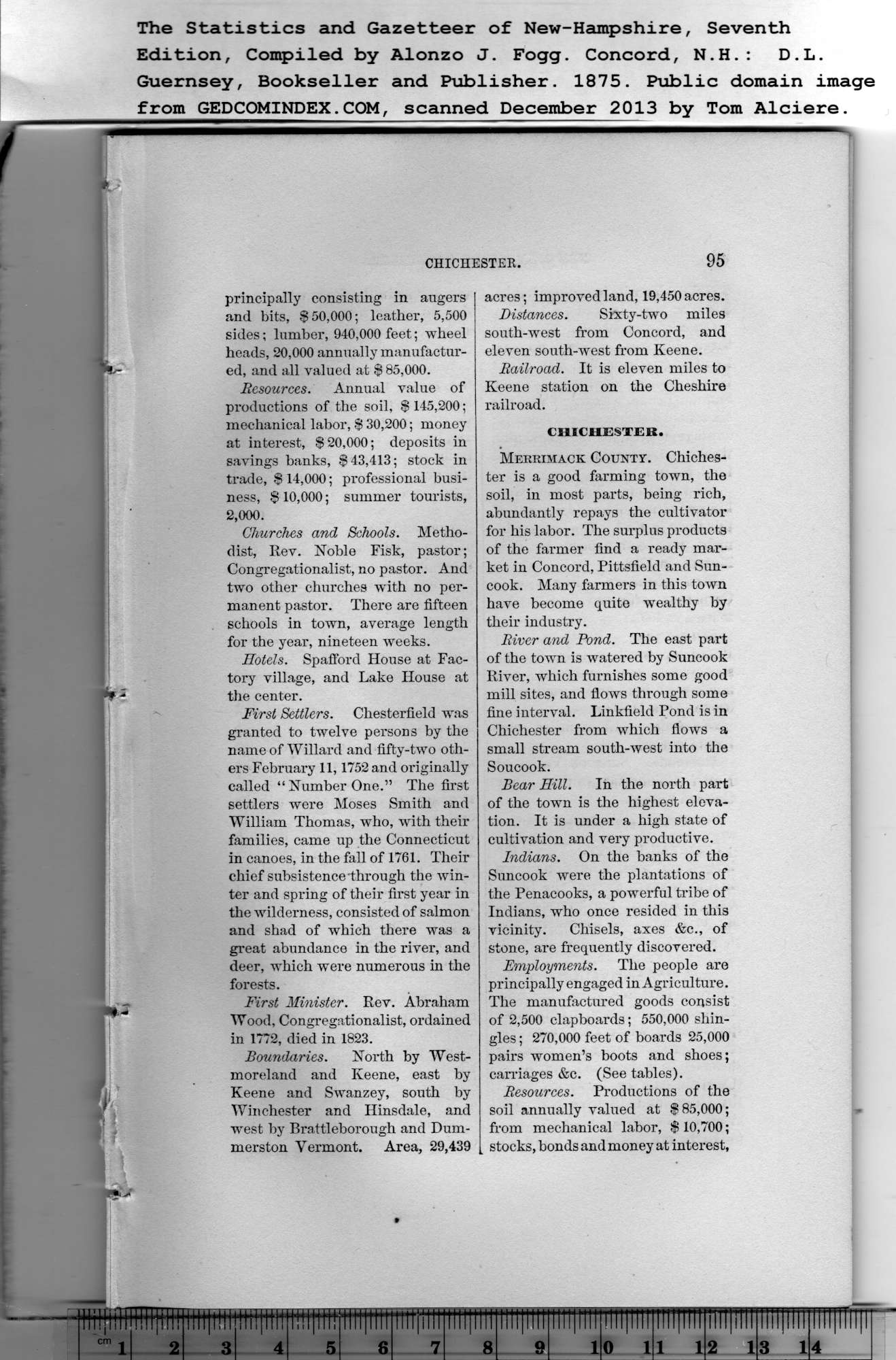|
principally consisting in augers
and bits, $50,000; leather, 5,500
sides; lumber, 940,000 feet; wheel
heads, 20,000 annually manufactur-
ed, and all valued at $ 85,000.
Resources. Annual value of
productions of the soil, $ 145,200;
mechanical labor, $ 30,200; money
at interest, $20,000; deposits in
savings banks, $43,413; stock in
trade, $ 14,000; professional busi-
ness, $ 10,000; summer tourists,
2,000.
Churches and Schools. Metho-
dist, Rev. Noble Fisk, pastor;
Congregationalist, no pastor. And
two other churches with no per-
manent pastor. There are fifteen
schools in town, average length
for the year, nineteen weeks.
Hotels. Spafford House at Fac-
tory village, and Lake House at
the center.
First Settlers. Chesterfield was
granted to twelve persons by the
name of Willard and fifty-two oth-
ers February 11,1752 and originally
called “ Number One.” The first
settlers were Moses Smith and
William Thomas, who, with their
families, came up the Connecticut
in canoes, in the fall of 1761. Their
chief subsistence'through the win-
ter and spring of their first year in
the wilderness, consisted of salmon
and shad of which there was a
great abundance in the river, and
deer, which were numerous in the
forests.
First Minister. Rev. Abraham
Wood, Congregationalist, ordained
in 1772, died in 1823.
Boundaries. North by West-
moreland and Keene, east by
Keene and Swanzey, south by
Winchester and Hinsdale, and
west by Brattleborough and Dum-
merston Vermont. Area, 29,439 |
acres; improved land, 19,450 acres.
Distances. Sixty-two miles
south-west from Concord, and
eleven south-west from Keene.
Railroad. It is eleven miles to
Keene station on the Cheshire
railroad.
CHICHESTER.
Merrimack County. Chiches-
ter is a good farming town, the
soil, in most parts, being rich,
abundantly repays the cultivator
for his labor. The surplus products
of the farmer find a ready mar-
ket in Concord, Pittsfield and Sun-
cook. Many farmers in this town
have become quite wealthy by
their industry.
River and Pond. The east part
of the town is watered by Suncook
River, which furnishes some good
mill sites, and flows through some
fine interval. Linkfield Pond is in
Chichester from which flows a
small stream south-west into the
Soucook.
Bear Hill. In the north part
of the town is the highest eleva-
tion. It is under a high state of
cultivation and very productive.
Indians. On the banks of the
Suncook were the plantations of
the Penacooks, a powerful tribe of
Indians, who once resided in this
vicinity. Chisels, axes &c., of
stone, are frequently discovered.
Employments. The people are
principally engaged in Agriculture.
The manufactured goods consist
of 2,500 clapboards; 550,000 shin-
gles ; 270,000 feet of boards 25,000
pairs women’s boots and shoes;
carriages &c. (See tables).
Resources. Productions of the
soil annually valued at $ 85,000;
from mechanical labor, $ 10,700;
stocks, bonds and money at interest, |
